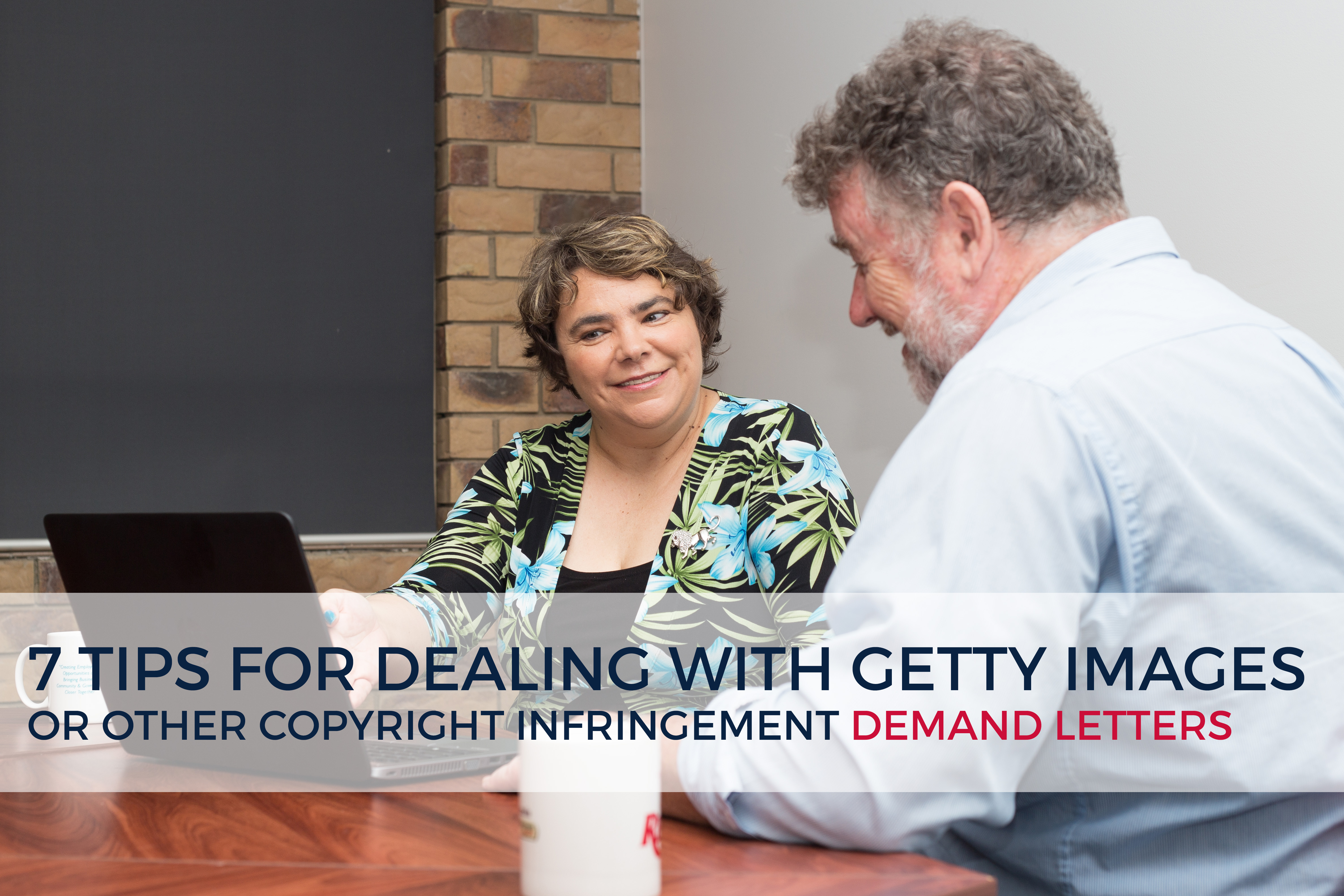7 tips for dealing with Getty Images or other copyright infringement demand letters -clone
Have you received a letter of demand accusing you of infringing copyright online? If you have, you’ve come to the right place, because I’m going to share with you my seven tips on how to overcome this problem. What it is: a letter of demand usually comes from the copyright owner — most often Getty Images — and it usually comes from Dun & Bradstreet, and it accuses people of having used an image online without paying the licensing fee. I’m going to give you a bonus tip. My bonus tip is don’t take advice online from random strangers, or even well trusted business coaches. They can be well meaning, but often legally incorrect. So, I am the Legal Lioness. My name is Cathryn Warburton. I am legally trained, and this is why I’m giving you some legal tips today.

1. Don’t panic! My mum recently had a fender bender, and her first instinct was panic, and she hopped out of the car and said, “I’m so sorry.” Please don’t do that. Not only with these types of letters of demand, but any type of letter of demand. Most clients who come to me, once they’ve already responded, their response has been, “I’m so sorry. I didn’t know I was infringing your copyright.” Ignorance of infringement is no excuse, it’s no defense, and if you say, “I’m sorry that I infringed,” you’ve admitted you’ve infringed, and just go and pay them because you’re going to have to pay them now you’ve admitted liability. So, don’t panic.
2. Don’t ignore. There’s a lot of advice out there these days that you should just ignore these letters of demand. My good friend Elaine, who is also my hypnotherapist, she decided this is what technique she was going to employ when she got a letter of demand. Honestly, they harassed her. They phoned her five, six, seven times a week, on weekends, after office hours. Sent so many letters. It was a mess of stress. More importantly, if they want to and you have infringed, they can take you to court. So, you go from having to pay maybe $1,500 to having to pay $1,500 plus their legal fees of 40, 50, $60,000. It makes absolutely no sense. Second tip, don’t ignore it.
3. Is it a scam? There are scammers out there pretending to be recovering copyright fees for copyright owners, so how do you know? Firstly, if they contact you by telephone only that could be an indicator that it’s a scam. If that happens, tell them to contact you in the usual way, and that you think it’s a scam and you’re going to contact the federal police. If they are genuine, they will know how to contact you. They will know how to find your address, and they will be in touch by sending you a letter. Please, don’t give them your address or your email address. If they don’t already have that, that could indicate they’re a scammer, so don’t give them any details.See who the letter’s from — usually Dun & Bradstreet. Hop online and check their details. Find the phone number online, and then phone them to discuss it. Do not use the phone number that they give you at the top of their letter, because if they are a scammer they’re going to just direct that to themselves instead of to the proper debt collection agency. So, you’ve taken step number three and checked to make sure it’s not a scam.
4. Compare the images, and make sure that they actually are similar. Now, I’ve been doing this for 20 years, and in that time I’ve never seen a single one that haven’t been virtually identical, but who knows? You could get lucky. Just check. Are they similar?
5. Do you actually have a license? You might. You might have paid to use this image. If you have a license, go and find it, send them a copy, and that basically is your get out of jail free card. So, if you’ve got a license, send it to them, and that’s the end of the story. You don’t have to pay them anything, and you can keep using it within the license terms.
6. Take the image down, don’t admit anything. Just take it down. once:
- You know that it is not a scam.
- You know that the images are similar.
- You know that you don’t have a license or you cannot prove you have a licence.
7. Negotiate with them. You can do it by phone. They will not talk to me on the phone anymore because I have had so many cases that I have negotiated down in price. They are trained to get as much money from you as they can, so they can be aggressive on the phone. You do not need a lawyer to help you with this negotiation. You can do it yourself. If that makes you nervous send them an email and make them a counter offer.Now, because I’ve been doing it for a while I can usually get them to agree to about 30% of their original demand, so you can see if their original was $1500, I could likely negotiate them down to $500 or $600 – it is not ideal, but if it gets you out of the sticky situation my advice is pay it and move on. Sometimes it can be very expensive. I had one client who had 10 images on her site, so with a demand of around $1500 was per image (remember this is not a fixed fee, and sometimes demands can be for more than $1500 per image). That poor client, she ended up with a $15 000 bill and, of course, in that case I helped her negotiate it down, but if you have just got a demand for one or two images it is not worth getting me involved. Do the negotiation yourself.
Very importantly, moving forward, make sure that anytime you use an image whether it is on a blog, Facebook, website, that you actually have got a license agreement. You’ve paid a royalty payment or an image payment, and you can put your hands on that license, so you can prove that you’ve got that license because that will protect you now going forward.
So, those are my seven tips: Don’t panic. Don’t ignore it. Check if it’s a scam. Are the images similar? Which they probably are. Do you have a license — your get out of jail free card? If you can’t find it or can’t prove it, number six is take it down. And number seven is negotiate the lowest amount you possibly can. Good luck with it.
© 2017 Acacia Law, litigation@acacialaw.com



